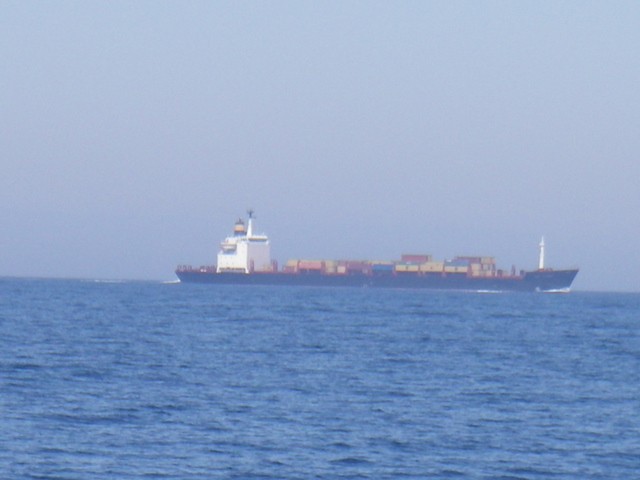Corfu to Aeolian islands

|
We waved a fond farewell, as Caroline was driven off in
the mini bus, to the airport in Next morning at a There was very little wind and the sea was flat so,
leaving It took us 35.5 hours to reach Rocella Ionica, on the
ball of the foot of
During the passage, we managed to sail for 40 minutes. There was insufficient wind and of course, it was head-on. For a couple of hours, from around 6am on the second day, we were able to use the cruising shute, as we motor sailed on a broad reach. Around
On both days, we saw the cavorting of dolphins, on several occasions, but none approached the boat. Dick saw a baby turtle. Perhaps it was hatched this year. Traveling in a busy shipping lane, we counted 23 ships.
However, having survived the dozens of ships, as we covered the first 50 miles
off shore from As we approached the ball of the foot of
When only a couple of hours from the unfinished marina at Rocella Ionica, where we planned to spend the night, the boat was gradually being navigated closer to the land. Suddenly, there was a flash of silver and what I believe was a swordfish, jumped three times out of the water. I sounded the fog horn to alert Dick but it was too late, the three flashes were all we were getting. As we entered the marina, a dredger was busy working on
the silted entrance, narrowing the channel considerably. We made our way to the
end of the marina and tied up alongside, passing another Lagoon 440, on the way.
Later that evening a third Lagoon 440 arrived and tied up in front of us. The
French owners, with a teenage son, spend 5 months on board each year, wintering
the boat in
The coastal route round the bottom of
We both slept well but because we hadn’t closed the mosquito blinds on the door, when we first arrived in port, in the early hours of the morning, I heard a mosquito in our cabin. So exhausted from the long passage, I just pulled the sheet over my head. The next day was spent doing various maintenance tasks. We were also able to use the water from the quayside, to wash the salt from the boat. A Lagoon 410 arrived and tied up behind us. The marina lights were lit. There is so much already in place at this marina and the general day-to-day running costs are being met by someone but there is no marina office and no-one seems to want to charge boats for being there. We left the marina just after We had a tow most of the way to the tip of the toe of
As we were passing the silted up marina of Saline
Ioniche, just before we turned into the
Dick took the first night watch from Although there was quite a lot of light from the coast of
Ahead, it looked as if a string of glittering diamonds had been strung out across the water, a few miles ahead, in the direction that we were heading. Gradually, as I approached the necklace, it broke up a little, with small fishing boats moving left and right and then back again. A new light would suddenly appear, as I approached a previously unlit boat. Other boats used flashing red or white lights and I feverishly checked the charts for beacons and lighthouses, to no avail. I could see the flashing light, from the lighthouse on
Vulcano, the southernmost of the We anchored just below the Gran Cratere, an active crater, observing the steaming fumaroles, from the comfort of our boat. Within an hour of our arrival, 8 ferry boats, hydrofoils, etc, had already arrived and they kept coming and going all day long, with as many as 3, at any one time, queuing for a space on the quayside. Going ashore was amazing. We motored up to where we thought the water would be too shallow to continue. I put my legs over the edge of the dinghy, ready to jump in and pull the boat to the shore but the water was still too deep for me to stand. Dick jumped in instead and was instantly soaked to his shorts. I couldn’t hang on to the edge of the dinghy any longer and gradually slipped further down into the water, until I was standing on the sea bottom. The water almost reached my chest. We manhandled the dinghy onto the beach, above the water line and waddled, in our wet clothes, past the bubbling mud pools, where men and women, of all shapes and sizes, were submerging their bodies in the grey mud. Back on Tucanon, as we were already wet, it seemed a good time for a swim in the bay. By moving closer and then withdrawing, from the numerous, hot, mineral springs, bubbling up from the sea-bed, we had fun selecting our preferred water temperature. The wind, as forecast, came up during the night. There are gale force winds in just about all sea areas except where we are at present. I am not complaining. This bay is open to all winds from north east to south east. With the wind blowing from the west and west, south west, even while it was gusting force 8, we were well protected. During the night, a number of boats had anchored in the part of the bay used during the day, by the constant stream of ferries. The smaller ferries were able to cope but after sounding its horn to obtain passage, to permit passengers and vehicles to disembark, receiving no assistance from any of those boats at anchor, one of the larger ferry boats had no choice but to turn around and depart.
Below: Cargo ship which had just crossed our bays and was on passage to Croatia
. |
